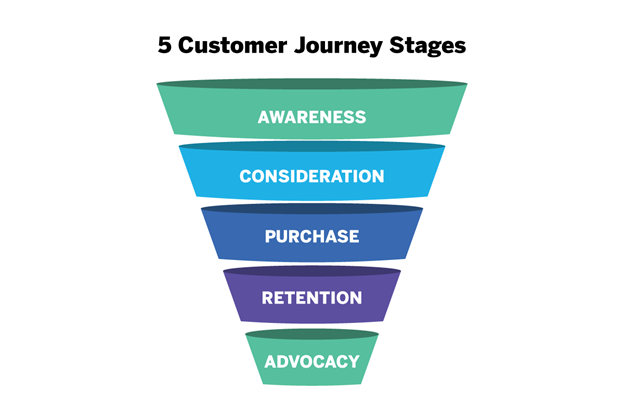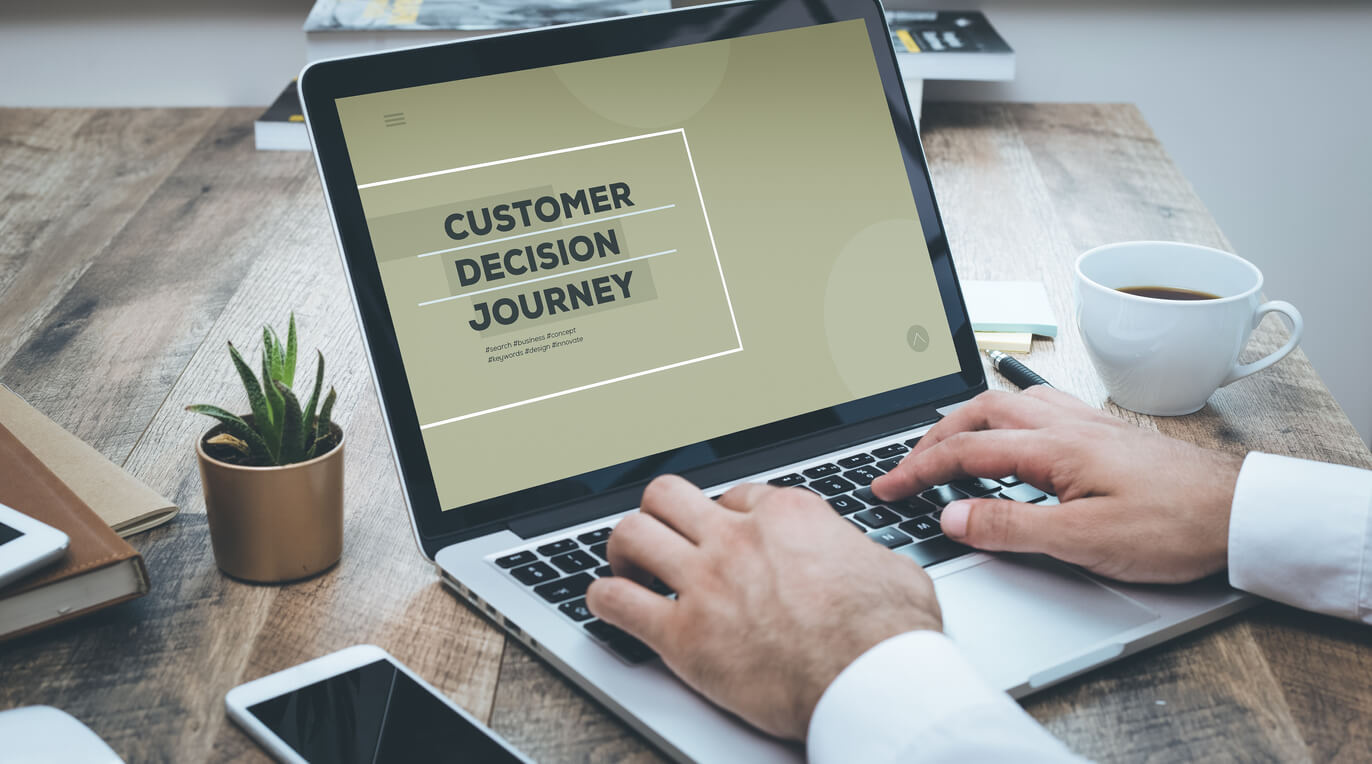Think back to a time when you were on a customer journey.
Perhaps you had just moved into a new home and needed a new living room couch. First, you may have hopped online to explore options, check out deals, and scope out the nearest furniture stores.
Next, you may have seen an ad on social media with a deal from one of the websites you visited. So, you decide to go check it out in person that weekend and are getting closer to making a decision.
You then go back online to see if you can get a better deal—visit more websites, walk through more stores, read more reviews, see more ads, and ultimately—after thorough online research and careful consideration you find the couch of your dreams and are ready to swipe your plastic.
The customer journey is comprised of unique behaviors and motivations at every stage. And, for your marketing, it’s important to understand these stages to personalize the experience and guide customers toward a buying decision that involves your product or service.
What is the Customer Journey?
The customer journey encapsulates a customer’s experience with a brand, product, or service from initial awareness to post-purchase interactions. It maps out various touchpoints and interactions a customer has along the way, including their research, consideration, purchase decision, and ongoing engagement. This journey is dynamic and can vary depending on the industry, product, and individual preferences.
The Importance of the Customer Journey
According to research, 81% of consumers go online to find information and answer any questions about the product or service before heading out to the store to make a purchase.
Additionally,
- 71% of shoppers say they use their mobile devices in stores to complete tasks such as purchasing to reading reviews.
- 95% of consumers read online reviews before visiting a business.
- 54% of shoppers buy online because they can easily comparison shop.
- 41% of online shoppers said positive customer reviews are the top motivator for online purchases.
- Four in 10 online shoppers say they would be more likely to convert if a product ad features some sort of User Generated Content (UGC). UGC could include customer reviews, customer photos, and even social posts.
5 Stages of the Customer Journey
Understanding the customer journey and how your ideal customer researchs and shops is key to running successful campaigns. The five stages of the customer journey are:
- Awareness
- Consideration
- Purchase
- Retention
- Advocacy

1. Awareness Stage
The journey begins when a potential customer becomes aware of your brand, product, or service. At this stage, they’ve identified a problem or need and seek information and solutions. Your goal is to grab their attention and make a positive first impression.
Key Strategies
- Content Marketing: Create informative blog posts, articles, videos, and infographics that address the pain points and interests of your target audience. The content should provide value and establish your brand as a trusted resource.
- Social Media Marketing: Share engaging content on social platforms to increase brand visibility and reach. Use paid advertising to target specific demographics or interests.
- Search Engine Optimization (SEO): Optimize your website content to rank higher in search engine results pages (SERPs) for relevant keywords, ensuring that potential customers can find you when searching for solutions.
2. Consideration Stage
In the consideration stage, potential customers evaluate their options. They compare different products or services and research which option best aligns with their needs. This is a critical stage where you can influence their decision-making process.
Key Strategies
- Informative Content: Produce detailed product guides, comparison charts, videos, and customer reviews to help potential customers make informed decisions.
- Email Marketing: Develop email campaigns that deliver valuable content, product comparisons, and customer testimonials to help potential customers evaluate their options.
- Ads: Use targeted ads to re-engage users who have previously visited your website but didn’t convert. Show them relevant products or content to keep your brand top of mind.
3. Purchase/Decision Stage
At this point, the customer is ready to make a decision and convert. They’ve narrowed down their choices and are looking for reasons to choose your product or service over others. Your goal is to provide the final nudge.
Key Strategies
- Clear Calls to Action (CTAs): Use compelling CTAs on your website and in marketing materials to encourage conversions.
- Special Offers: Offer limited-time promotions, discounts, or exclusive bundles to incentivize the purchase.
- Trust Signals: Highlight trust factors like customer reviews, industry awards, and money-back guarantees to build confidence.
- Live Chat and Support: Provide real-time chat support to answer questions and assist with the decision-making process.
4. Retention Stage
The journey doesn’t stop after the purchase. It’s just the beginning of a potentially long-lasting relationship. In the post-purchase stage, your focus must shift to customer retention, loyalty, and advocacy.
Key Strategies
- Customer Feedback: Gather feedback to understand customer satisfaction and areas for improvement.
- Loyalty Programs: Implement loyalty programs that reward repeat purchases and referrals.
5. Advocacy Stage
In this stage, the goal is to encourage satisfied customers to become enthusiastic promoters of your brand. In this stage, customers have established a strong and positive relationship with your brand, and are excited to tell their friends, family, and the world about you. Encourage satisfied customers to become advocates through reviews, testimonials, influencer marketing, and word-of-mouth referrals.
Key Characteristics of the Advocacy Stage Include:
- Loyalty: Customers in this stage are loyal to the brand and often prefer its products or services over competitors. They are repeat buyers who continue to engage with the business.
- Advocacy: Advocates go beyond being loyal customers; they actively promote the brand to others. They might recommend the brand to friends, family, or colleagues, write positive reviews, share their experiences on social media, or participate in referral programs.
- Word-of-Mouth Marketing: Advocacy often involves organic word-of-mouth marketing, where satisfied customers spread positive messages about the brand, effectively becoming brand ambassadors.
- Higher Lifetime Value: Advocates tend to have a higher lifetime value to the business. Not only do they make repeat purchases, they attract new customers through their recommendations and referrals. At the end of the day, social proof is one of your strongest brand assets.
Conclusion
Understanding the customer journey helps you build strong relationships with your customers. Each stage presents unique opportunities and challenges. By personalizing your strategies to address customers’ needs along the path to purchase, you can enhance their experience and drive long-term success for your brand.




